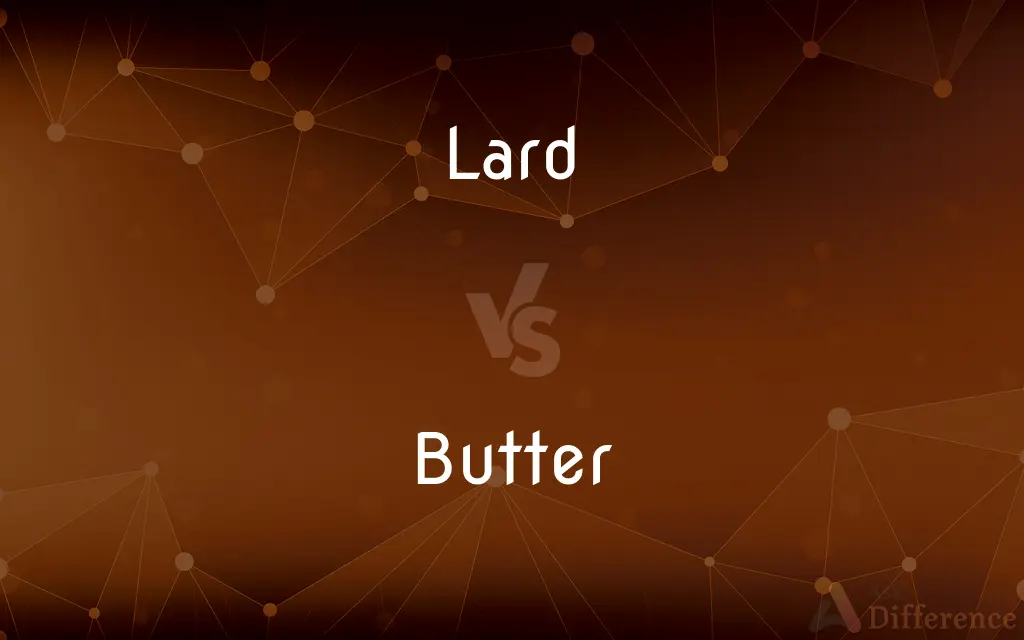Lard vs. Butter — What's the Difference?
By Tayyaba Rehman — Updated on October 9, 2023
Lard is rendered pig fat; Butter is a dairy product made by churning cream.

Difference Between Lard and Butter
Table of Contents
ADVERTISEMENT
Key Differences
Lard, derived from rendered pig fat, is a traditional fat used for cooking and baking. Butter, on the other hand, is a familiar dairy product produced by churning cream. While both Lard and Butter serve as fats in culinary applications, their origins and characteristics set them apart.
Lard is primarily animal-based, coming specifically from pigs, and possesses a distinct flavor and texture. Butter, being a product of cream, showcases a rich, creamy taste and a slightly yellowish hue. These flavor distinctions mean that Lard and Butter impart different tastes to dishes.
In terms of consistency, Lard is often softer at room temperature compared to Butter. The latter, made from milk fats, tends to be firmer. This difference in texture can influence the outcome of baked goods, with Lard typically making for flakier pastries than Butter.
Historically, Lard was a staple in many cuisines due to its widespread availability and long shelf life. Butter, with its dairy origins, became prevalent in regions with prominent dairy farming. In today's culinary world, some prefer Lard for certain dishes due to its unique taste, while Butter remains a universal favorite for its rich flavor and versatility.
Comparison Chart
Origin
Rendered pig fat
Churned cream
ADVERTISEMENT
Flavor
Distinct, based on pork
Rich and creamy
Consistency
Softer at room temperature
Firmer at room temperature
Color
White or off-white
Yellowish
Common Uses
Frying, baking, pastries
Cooking, baking, spreading, sauces
Compare with Definitions
Lard
Lard is fat from pigs.
She used Lard to make the pie crust flaky.
Butter
Butter is made from churned cream.
She spread Butter on her toast for breakfast.
Lard
Lard is used for frying due to its high smoke point.
He fried the donuts in Lard for a crispy exterior.
Butter
Butter is a dairy product.
The creamy Butter enhanced the flavor of the mashed potatoes.
Lard
Lard is prized in pastries for flakiness.
The secret to her biscuits' texture was Lard.
Butter
Butter can be salted or unsalted.
He used unsalted Butter in the recipe to control the salt level.
Lard
Lard is often rendered to purify it.
The Lard was rendered to remove impurities.
Butter
Butter has a rich and creamy taste.
The sauce was made velvety with the addition of Butter.
Lard
Lard has been a cooking staple for centuries.
Traditional recipes often call for Lard for its unique taste.
Butter
Butter is a dairy product made from the fat and protein components of churned cream. It is a semi-solid emulsion at room temperature, consisting of approximately 80% butterfat.
Lard
Lard is a semi-solid white fat product obtained by rendering the fatty tissue of a pig. It is distinguished from tallow, a similar product derived from fat of cattle or sheep.
Butter
A pale yellow edible fatty substance made by churning cream and used as a spread or in cooking.
Lard
Fat from the abdomen of a pig that is rendered and clarified for use in cooking.
Butter
Spread (something) with butter
Lily buttered a slice of toast
Lard
Insert strips of fat or bacon in (meat) before cooking
He larded the joint with garlic and anchovies
Butter
A soft yellowish or whitish emulsion of butterfat, water, air, and sometimes salt, churned from milk or cream and processed for use in cooking and as a food.
Lard
Embellish (talk or writing) with an excessive number of esoteric or technical expressions
His conversation is larded with quotations from Coleridge
Butter
A spread made from fruit, nuts, or other foods
Plum butter.
Cashew butter.
Lard
The white solid or semisolid rendered fat of a hog.
Butter
A vegetable fat having a nearly solid consistency at ordinary temperatures.
Lard
To cover or coat with lard or a similar fat.
Butter
Flattery.
Lard
To insert strips of fat or bacon in (meat) before cooking.
Butter
To put butter on or in.
Lard
To enrich or lace heavily with extra material; embellish
Larded the report with quotations.
Butter
A soft, fatty foodstuff made by churning the cream of milk (generally cow's milk).
Lard
To fill throughout; inject
"The history of Sicily was larded with treachery" (Mario Puzo).
Butter
Any of various foodstuffs made from other foods or oils, similar in consistency to, eaten like or intended as a substitute for butter (preceded by the name of the food used to make it).
Peanut butter
Soy butter
Chocolate butter
Lard
Fat from the abdomen of a pig, especially as prepared for use in cooking or pharmacy.
Butter
Any of various substances made from other (especially plant-based) oils or fats, used in moisturizers, cosmetics, etc.
Lard
(obsolete) Fatty meat from a pig; bacon, pork.
Butter
Any specific soft substance.
Butter of antimony; butter of arsenic
Lard
(slang) Excess fat on a person or animal.
Butter
A smooth plane landing.
Lard
(cooking) To stuff (meat) with bacon or pork before cooking.
Butter
Someone who butts, or who butts in.
Lard
To smear with fat or lard.
Butter
(transitive) To spread butter on.
Butter the toast.
Lard
To garnish or strew, especially with reference to words or phrases in speech and writing.
Butter
To move one's weight backwards or forwards onto the tips or tails of one's skis or snowboard so only the tip or tail is in contact with the snow. Similar to applying butter to bread with then end of a butterknife.
Lard
To fatten; to enrich.
Butter
To spin on skis or a snowboard using only the tips or tails being in contact with the snow
Lard
To grow fat.
Butter
To increase (stakes) at every throw of dice, or every game.
Lard
To mix or garnish with something, as by way of improvement; to interlard.
Butter
Very smooth, very soft
That landing was total butter!
Lard
Bacon; the flesh of swine.
Butter
An oily, unctuous substance obtained from cream or milk by churning.
Lard
The fat of swine, esp. the internal fat of the abdomen; also, this fat melted and strained.
Butter
Any substance resembling butter in degree of consistence, or other qualities, especially, in old chemistry, the chlorides, as butter of antimony, sesquichloride of antimony; also, certain concrete fat oils remaining nearly solid at ordinary temperatures, as butter of cacao, vegetable butter, shea butter.
Lard
To stuff with bacon; to dress or enrich with lard; esp., to insert lardons of bacon or pork in the surface of, before roasting; as, to lard poultry.
And larded thighs on loaded altars laid.
Butter
One who, or that which, butts.
Lard
To fatten; to enrich.
[The oak] with his nuts larded many a swine.
Falstaff sweats to death.And lards the lean earth as he walks along.
Butter
To cover or spread with butter.
I know what's what. I know on which sideMy bread is buttered.
Lard
To smear with lard or fat.
In his buff doublet larded o'er with fatOf slaughtered brutes.
Butter
To increase, as stakes, at every throw or every game.
Lard
To mix or garnish with something, as by way of improvement; to interlard.
Let no alien Sedley interposeTo lard with wit thy hungry Epsom prose.
Butter
An edible emulsion of fat globules made by churning milk or cream; for cooking and table use
Lard
To grow fat.
Butter
A fighter who strikes the opponent with his head
Lard
Soft white semisolid fat obtained by rendering the fatty tissue of the hog
Butter
Spread butter on;
Butter bread
Lard
Prepare or cook with lard;
Lard meat
Butter
Butter is solid at room temperature.
She left the Butter out to soften for baking.
Lard
Add details to
Common Curiosities
What is the primary source of Lard?
Lard is sourced from rendered pig fat.
Which is more flavorful: Lard or Butter?
Both have distinct flavors; Butter is creamy while Lard has a unique pork-based taste.
How is Butter produced?
Butter is produced by churning cream.
Can you substitute Lard for Butter in recipes?
Yes, but it can alter the flavor and texture of the dish.
Is Lard suitable for vegetarians?
No, since Lard comes from animals, it's not vegetarian.
Can Butter be made at home?
Yes, Butter can be made by churning heavy cream.
Why is Butter yellow?
Butter's yellowish hue comes from the beta-carotene in the cream.
Is Lard used in modern cooking?
While less common than before, Lard is still used, especially in traditional recipes.
Is Lard healthier than Butter?
Both have their pros and cons; it's essential to consider the specific nutritional needs.
Which has a higher smoke point: Lard or Butter?
Lard typically has a higher smoke point than Butter.
Does Butter always contain salt?
No, Butter can be salted or unsalted.
Can Lard and Butter be mixed in recipes?
Yes, some recipes might combine both for specific textures and flavors.
Which is better for baking: Lard or Butter?
It depends on the desired outcome; Lard makes pastries flakier, while Butter provides a rich flavor.
Can you spread Lard on bread like Butter?
While possible, Lard doesn't have the same creamy taste as Butter.
What is the shelf life of Lard and Butter?
Lard has a longer shelf life than Butter, but both should be stored properly.
Share Your Discovery

Previous Comparison
Yak vs. Ox
Next Comparison
City vs. ProvinceAuthor Spotlight
Written by
Tayyaba RehmanTayyaba Rehman is a distinguished writer, currently serving as a primary contributor to askdifference.com. As a researcher in semantics and etymology, Tayyaba's passion for the complexity of languages and their distinctions has found a perfect home on the platform. Tayyaba delves into the intricacies of language, distinguishing between commonly confused words and phrases, thereby providing clarity for readers worldwide.














































